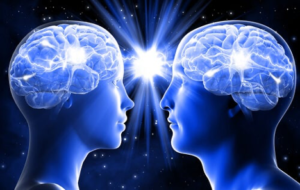The Connection Between Eye Contact and Your Brain

Eye contact is very powerful. In fact, a study demonstrates exactly what happens in your brain when you set eyes on someone for the very first time. In other words, it examined the connection between eye contact and your brain.
Everyone knows the power of eye contact with another human being. It’s a special process, as you’re transferring information about yourself to another person and they’re doing the same to you. In fact, when you make eye contact with someone, you’re sharing your emotional and mental state with them.
You only need to exchange glances to communicate something to a good friend. And with a simple gaze, you can enter into your loved one’s inner world. In fact, eye contact activates your social brain, your intentions, and your emotions.
This new study we mentioned above was conducted with magnetic resonance imaging. It reveals what activates eye contact in your brain, both in real and deferred time. In fact, when you make eye contact, you synchronize your blinking with the other person’s. But there’s a lot more to it than that.
Eye contact, blinking, and your brain
It seems that eye contact activates your social brain, which then synchronizes your eye movements and blinking with those of the person you’re looking at. That means that neural activation occurs.

Eye contact is one of the most outstanding forms of automatic mimicry. It’s also the way in which you tell another person you’re noticing them. It promotes social interaction and enables you to communicate effectively. Eye blinking expresses cognitive load, which projects your inner state.
Until now, brain imaging studies were only able to study the brain activity of a single person at any given time. But now, Nohiro Sadato’s team from the National Institute for Physiological Sciences in Japan have begun working with a novel technique known as hyperscanning.
The study: eye contact and your brain
The results of this experiment showed what happens in the brain when two people first see each other. Hyperscanning has made it possible to simultaneously observe the brains of two people communicating visually on two separate functional MRI machines. Sadato’s team studied 32 people grouped into pairs by putting them inside two MRI machines at the same time.
The experiment couldn’t be performed with the participants facing each other because MRI imaging required them to stay inside the machine and remain completely still.
Each scanner was equipped with a video screen and a camera. The participants didn’t know each other, so they’d never made eye contact with each other before. Blinking was used as the marker of synchronization between the participants.
The experiment measured the brain activity of the two participants in two different phases. In the first phase, they were shown a blank screen. Then, they were shown the image of their experiment partner, who they didn’t know. They were shown the image in real-time first and then with a 20-second delay. They were instructed to focus on what they thought the other person was thinking. Also, what their personality would be like or how they were feeling.
Study results: eye contact and your brain
Firstly, there were significant differences between the brain activation captured in real-time eye contact and the eye contact produced with a delay.
Real-time participants were more sensitive to the other person’s blinks than in the delayed images. There was also greater connectivity in the limbic mirror system and increased activity in the cerebellum.
The study showed that eye contact prepares your social brain to develop empathy and that it activates the same brain areas in two people at the same time. Activation of your cerebellum helps predict the sensory consequences of actions.
“Our findings suggest that perceptual–motor interaction occurs during eye contact without conscious awareness.”
-Norohiro Sadato-

Our brain’s incredible ability
The limbic system is associated with your ability to share and recognize emotions, which is essential for empathy. There seems to be a strong mutual influence in the blinks of two people when they make eye contact.
This means that eye contact prepares your social brain to share your mental state with other people. Furthermore, it provides the basis for you to communicate effectively. Finally, this study showed that your brain unconsciously differentiates between real-time and recorded images. This is the most significant fact of all regarding the connection between eye contact and the brain.
https://exploringyourmind.com/the-secrets-of-eye-contact/
This text is provided for informational purposes only and does not replace consultation with a professional. If in doubt, consult your specialist.








